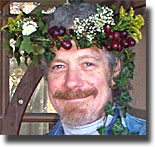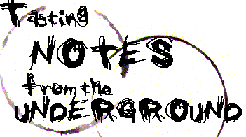|
||||
|
|
||||
|
And so it was that we had the opportunity to try the latest edition of Foillard’s "Cote du Py" a few weeks ago. Besides the 2001, we’ve also had the 2002 (quite good) and the 2005 (a beautiful wine), and the 2006 version seems clearly to be the most age-worthy of them all. 2006 Jean Foillard Morgon "Cote du Py," 13% alc., 29.99: A slightly smoky ruby garnet in color, and an obviously young wine, not nearly as voluptuous in its youth as the ’01 or ’05, but having said that, it is full of great promise for future development. As it stands now, it shows that unique character that can only come from Gamay, offering dusty black cherry aromatics and pretty black cherry, raspberry and strawberry flavors underscored with a subtle earthiness. There’s serious concentration here, and ample structure for at least five years cellaring, and more likely ten. An hour or two of air helps to make it more than approachable already, but it’s be best to be patient with this one. Find this wine |
||||
|
 Wyncroft’s
Jim Lester stopped in a few weeks ago to let us try his latest
offerings, which is always a must-do for us when we get the chance. We’ve made
no secret of just how much
we enjoy the wines that he and his wife Rae Lee make in southwestern Michigan
from grapes they grow, and in fact, a recent reconnoiter in the
cellar from heck revealed that we have accumulated several cases of their
goodies, with more on the way.l Wyncroft’s
Jim Lester stopped in a few weeks ago to let us try his latest
offerings, which is always a must-do for us when we get the chance. We’ve made
no secret of just how much
we enjoy the wines that he and his wife Rae Lee make in southwestern Michigan
from grapes they grow, and in fact, a recent reconnoiter in the
cellar from heck revealed that we have accumulated several cases of their
goodies, with more on the way.lJim told me that he was very interested in what Kim and I thought about this first wine, because he and Rae Lee were unsure as to whether or not it lives up to our standards. With a lead in like that, we were just as interested in finding out what was in the bottle, and frankly, we liked it well enough to buy some for ourselves! 2005 Wyncroft Lake Michigan Shore Riesling Avonlea Vineyard, 13% alc., $20: Grown in mineral rich hard clay with chunks of slate throughout, to which Jim attributes a certain savory characteristic in the wine, this was fermented in food grade plastic and bottled in the summer of 2006, at which time, it showed very little in the way of aromatics. While not exactly effusive, it has certainly opened on the nose since then, showing some nice green apple, mineral and a hint of petrol. There’s plenty more where that came from on the palate, and Jim adds his own impressions or hard pear and grapefruit. The wine is steely and bone dry, with solid Riesling character, good balance and excellent cut, and if it’s not as expressive as the excellent 1999 version, it performs quite well on its own behalf. It also improves with air, and will improve even more with some time in the bottle. Find this wine
Although not a new vintage, we opened the following
wine a few nights after Jim’s visit just to see where it’s at.  We
received a visit from another fine winemaker last month in the person of
Joseph Landron,
from Muscadet Sevre et Maine in France’s western Loire Valley.
I
first met Joe in the early summer of 2006, and quite enjoyed chatting
with him and tasting his wines then. This occasion was even more enjoyable,
because he brought more of his wines along to try! We
received a visit from another fine winemaker last month in the person of
Joseph Landron,
from Muscadet Sevre et Maine in France’s western Loire Valley.
I
first met Joe in the early summer of 2006, and quite enjoyed chatting
with him and tasting his wines then. This occasion was even more enjoyable,
because he brought more of his wines along to try!Landron makes wines from the family domaine, La Louvetrie (64 acres), and the “rented property,” Le Chateau de la Cariziere (38 acres). The vineyards are farmed organically since 1999; they are “entirely ploughed in order to taste a stronger minerality in the wine,” and treatment of the vines includes sulfur, plant based and copper based products. Joe fertilizes with organic compost and calcium lithotame. With a vine density of 7000 plants per hectare, buds per vine are limited to eight in order to regulate the produce to 50 hectolitre per hectare. In some years, in some hillside vineyards such as Fief du Breil and Clos de la Carizière, the fruit is thinned to bring the produce closer to 40 hectolitres per hectare for more concentration and to avoid stressing the vines. The harvested grapes are pressed pneumatically and fermented with indigenous yeast in thermo-regulated glass-coated cement vats, spending anywhere from 6 to 12 months on the lees. (Each vineyard’s fruit is fermented separately to maintain their specific, distinctive characteristics.) The wines are then bottled directly from the high tanks by gravity feed.  2006 Joseph Landron Muscadet Sevre et Maine Sur Lie Chateau de la Cariziere, 12%
alc., 12.99: Pale straw color, with a fairly pungent green apple and
smoky-mineral nose and more of the same in the mouth, with the mineral
dominating. Indeed, Joe says that this is showing more of that quality than it
did three or four months ago. Good weight and length, with plenty of the
requisite acids that you’d expect from fine Muscadet Sevre et Maine. Find this wine 2006 Joseph Landron Muscadet Sevre et Maine Sur Lie Chateau de la Cariziere, 12%
alc., 12.99: Pale straw color, with a fairly pungent green apple and
smoky-mineral nose and more of the same in the mouth, with the mineral
dominating. Indeed, Joe says that this is showing more of that quality than it
did three or four months ago. Good weight and length, with plenty of the
requisite acids that you’d expect from fine Muscadet Sevre et Maine. Find this wine2007 Joseph Landron Muscadet Sevre et Maine Sur Lie Chateau de la Cariziere, 12% alc., $12.99: This pale straw will be arriving in May; at this point, it shows more fruit and less mineral on the nose than does the ’06, with still-fermenting aromas of lemony green apple. However, it gives a lot of mineral on the palate, again, with good weight, length and acidity. Landron considers this a real success, due to the considerable rainfall from May through July. The good weather returned in August, but harvest was delayed by two weeks and yields were reduced by more than half. Find this wine 2007 Joseph Landron Muscadet Sevre et Maine Amphibolite Nature, 11.2% alc., $15.60: Made to be consumed fresh, within the first year after release, this pale straw gives bone dry, mineral-heavy white fruit (but less fruit than the la Carizieres), with good weight and length and nice density and intensity of flavor. Amphibolite refers to the particular amphibole rocks found throughout the soil in which the grapes are grown. Find this wine  2004 Joseph Landron Muscadet Sevre et Maine Sur Lie Domaine de la Louvetrie
“Hermine d’Or,” 12% alc., $12.99: Pale to medium straw in color, this particular
cuvee comes from 35 hectares of 40+ year old vines grown in quartz-laden soil.
It shows a little less mineral and a little more fruit than the previous
selections, but again, the wine is bone dry, with quince, green apple and smoky
mineral flavors and aromas. Balanced and harmonious, this is a complete wine
that has benefited from some time in the bottle. It’s ready to drink, and nicely
so, which is why we’ve purchased more for personal consumption. Find this wine 2004 Joseph Landron Muscadet Sevre et Maine Sur Lie Domaine de la Louvetrie
“Hermine d’Or,” 12% alc., $12.99: Pale to medium straw in color, this particular
cuvee comes from 35 hectares of 40+ year old vines grown in quartz-laden soil.
It shows a little less mineral and a little more fruit than the previous
selections, but again, the wine is bone dry, with quince, green apple and smoky
mineral flavors and aromas. Balanced and harmonious, this is a complete wine
that has benefited from some time in the bottle. It’s ready to drink, and nicely
so, which is why we’ve purchased more for personal consumption. Find this wine2004 Joseph Landron Muscadet Sevre et Maine Sur Lie Domaine de la Louvetrie, 12% alc.: Pale to medium straw in color, grapes for this were sourced from 45 year-old vines a warmer southern exposure; it spent 18 months in vat. It offers a fragrant green apple, quince and mineral nose that follows through nicely on the palate, rich yet bone dry at the same time. It shows good weight, acids and length, with a fine balance of fruit and mineral, with neither dominating. A harmonious wine for current consumption, and the reader can probably tell, this and the “Hermine d’Or” are my two favorites among these five nice wines. Find this wine Imported by Eagle Eye Imports LLC, Bloomfield Hills, MI Reporting from Day-twah,
Bastardo
Other Recent Wine Explorations
More Red Wings & Red Rhônes 2007: Champagne Tablas Swan Zin (a real mixed bag of goodies)
Dressner Does Day-Twah
Back to the Underground Index
|
||||








